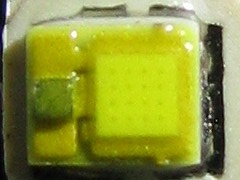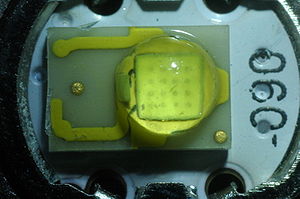Philips Lumileds: Difference between revisions
(add picture of Luxeon C) |
(add Luxeon TX) |
||
| (5 intermediate revisions by the same user not shown) | |||
| Line 1: | Line 1: | ||
Philips Lumileds Lighting Company is based in San Jose, California. It was started in 1999 as a joint venture between Philips and Agilent (spun off of HP), but in 2005 Philips bought Agilent's share, so now it is part of Philips. They developed some of the first power | Philips Lumileds Lighting Company is based in San Jose, California. It was started in 1999 as a joint venture between Philips and Agilent (spun off of HP), but in 2005 Philips bought Agilent's share, so now it is part of Philips. They developed some of the first power LEDs to be used in flashlights, like the Luxeon I, III, and V, and continue to produce the Luxeon Rebel. Red and blue Rebel LEDs are used in the household lightbulb that won the [http://www.philipslumileds.com/L-Prize L Prize] for Philips in 2011. | ||
==Luxeon C== | ==Luxeon C== | ||
| Line 64: | Line 64: | ||
|- | |- | ||
|X || 154-165 || 280-300 || 372-400 | |X || 154-165 || 280-300 || 372-400 | ||
|} | |||
==Luxeon T== | |||
Slightly larger than the Cree XP-G at 3.7 mm square, the Luxeon T is binned at 700mA and 85°C with a maximum current of 1000mA. The Luxeon T was introduced in December 2012. The LED is available in CRI values of 70, 80, and 90. Tints are based on ANSI White points (27 corresponds to 2700K, up to 57 for 5700K). To compare to other LEDs which often use 25°C as the temperature, the values below have been increased by 8% from the [http://www.philipslumileds.com/uploads/382/DS106-pdf datasheet]. | |||
{|class="wikitable" style="text-align: center; width: 400px;" | |||
|+ Luxeon T Brightness Bins (at 25°C)<BR>(lumens) | |||
|- | |||
!Bin !! 350mA<BR>54% || 700mA<BR>100% !! 1000mA<BR>136% | |||
|- | |||
|D || 76-82 || 140-151 || 191-206 | |||
|- | |||
|E || 82-87 || 151-162 || 206-220 | |||
|- | |||
|F || 87-93 || 162-173 || 220-235 | |||
|- | |||
|G || 93-99 || 173-184 || 235-250 | |||
|- | |||
|H || 99-105 || 184-194 || 250-264 | |||
|- | |||
|J || 105-111 || 194-205 || 264-279 | |||
|- | |||
|K || 111-117 || 205-216 || 279-294 | |||
|- | |||
|L || 117-122 || 216-227 || 294-308 | |||
|- | |||
|M || 122-128 || 227-238 || 308-323 | |||
|- | |||
|'''N*''' || 128-134 || 238-248 || 323-338 | |||
|} | |||
==Luxeon TX== | |||
An improved version of the Luxeon T, the TX was introduced in October 2013 offering 20% higher output. The LEDs are binned at 85°C, but are increased by 6% to get the value at 25°C. In December 2015, [[Olight]] introduced the latest version of the i3 EOS with Luxeon TX LED. | |||
{|class="wikitable" style="text-align: center; width: 400px;" | |||
|+ Luxeon TX Brightness Bins (at 25°C)<BR>(lumens) | |||
|- | |||
!Bin !! 350mA<BR>55% || 700mA<BR>100% !! 1000mA<BR>134% | |||
|- | |||
|J || 103-109 || 191-201 || 259-274 | |||
|- | |||
|K || 109-114 || 201-212 || 274-288 | |||
|- | |||
|L || 114-120 || 212-223 || 288-303 | |||
|- | |||
|M || 120-126 || 223-233 || 303-317 | |||
|- | |||
|N || 126-132 || 233-244 || 317-332 | |||
|- | |||
|P || 132-137 || 244-254 || 332-346 | |||
|- | |||
|Q || 137-143 || 254-265 || 346-360 | |||
|- | |||
|R || 143-149 || 265-276 || 360-375 | |||
|- | |||
|S || 149-155 || 276-286 || 375-389 | |||
|- | |||
|'''T*''' || 155-160 || 286-297 || 389-404 | |||
|- | |||
|U || 160-166 || 297-307 || 404-418 | |||
|- | |||
|V || 166-172 || 307-318 || 418-432 | |||
|- | |||
|W || 172-177 || 318-329 || 432-447 | |||
|} | |} | ||
Latest revision as of 22:55, 1 February 2016
Philips Lumileds Lighting Company is based in San Jose, California. It was started in 1999 as a joint venture between Philips and Agilent (spun off of HP), but in 2005 Philips bought Agilent's share, so now it is part of Philips. They developed some of the first power LEDs to be used in flashlights, like the Luxeon I, III, and V, and continue to produce the Luxeon Rebel. Red and blue Rebel LEDs are used in the household lightbulb that won the L Prize for Philips in 2011.
Luxeon C

The Luxeon C looks similar to the Rebel, but is about a quarter of the size, has a flat window over the emitter instead of a dome, and is designed for less current. It was first introduced in March 2010. This LED is used in the Maglite Solitaire and 2xAAA Mini Maglite, introduced in 2012. Datasheet
| Bin | 350mA 100% |
500mA 133% |
|---|---|---|
| 7 | 80-90 | 106-120 |
| 8 | 90-100 | 120-133 |
Luxeon Rebel

Used in a number of different Maglites flashlights. Also used in early versions of Fenix LxD/PxD series. Datasheet
| Bin | 350mA 100% |
700mA 175% |
1000mA 225% |
|---|---|---|---|
| H | 50-60 | 88-105 | 113-135 |
| J | 60-70 | 105-123 | 135-158 |
| K | 70-80 | 123-140 | 158-180 |
| L | 80-90 | 140-158 | 180-203 |
| M | 90-100 | 158-175 | 203-225 |
| N | 100-120 | 175-210 | 225-270 |
| P | 120-140 | 210-245 | 270-315 |
| Q | 140-160 | 245-280 | 315-360 |
| R | 160-180 | 280-315 | 360-405 |
| S | 180-200 | 315-350 | 405-450 |
Luxeon Rebel ES
Same size package as the regular Rebel but with a larger die under the dome, the Rebel ES is capable of output of 200 lumens at 700mA and 320 lumens at 1000mA. The brightness bins below are not directly comparable to the ones above since the ES series are rated at a higher current. Datasheet
| Bin | 350mA 55% |
700mA 100% |
1000mA 133% |
|---|---|---|---|
| T | 110-121 | 200-220 | 267-293 |
| U | 121-132 | 220-240 | 293-320 |
| V | 132-143 | 240-260 | 320-347 |
| W | 143-154 | 260-280 | 347-372 |
| X | 154-165 | 280-300 | 372-400 |
Luxeon T
Slightly larger than the Cree XP-G at 3.7 mm square, the Luxeon T is binned at 700mA and 85°C with a maximum current of 1000mA. The Luxeon T was introduced in December 2012. The LED is available in CRI values of 70, 80, and 90. Tints are based on ANSI White points (27 corresponds to 2700K, up to 57 for 5700K). To compare to other LEDs which often use 25°C as the temperature, the values below have been increased by 8% from the datasheet.
| Bin | 350mA 54% |
700mA 100% |
1000mA 136% |
|---|---|---|---|
| D | 76-82 | 140-151 | 191-206 |
| E | 82-87 | 151-162 | 206-220 |
| F | 87-93 | 162-173 | 220-235 |
| G | 93-99 | 173-184 | 235-250 |
| H | 99-105 | 184-194 | 250-264 |
| J | 105-111 | 194-205 | 264-279 |
| K | 111-117 | 205-216 | 279-294 |
| L | 117-122 | 216-227 | 294-308 |
| M | 122-128 | 227-238 | 308-323 |
| N* | 128-134 | 238-248 | 323-338 |
Luxeon TX
An improved version of the Luxeon T, the TX was introduced in October 2013 offering 20% higher output. The LEDs are binned at 85°C, but are increased by 6% to get the value at 25°C. In December 2015, Olight introduced the latest version of the i3 EOS with Luxeon TX LED.
| Bin | 350mA 55% |
700mA 100% |
1000mA 134% |
|---|---|---|---|
| J | 103-109 | 191-201 | 259-274 |
| K | 109-114 | 201-212 | 274-288 |
| L | 114-120 | 212-223 | 288-303 |
| M | 120-126 | 223-233 | 303-317 |
| N | 126-132 | 233-244 | 317-332 |
| P | 132-137 | 244-254 | 332-346 |
| Q | 137-143 | 254-265 | 346-360 |
| R | 143-149 | 265-276 | 360-375 |
| S | 149-155 | 276-286 | 375-389 |
| T* | 155-160 | 286-297 | 389-404 |
| U | 160-166 | 297-307 | 404-418 |
| V | 166-172 | 307-318 | 418-432 |
| W | 172-177 | 318-329 | 432-447 |
Past Products
Luxeon I a 1-watt LED capable of producing 30-60 lumens at 350mA, this LED was used in the Fenix L1S
Luxeon III a 3-watt LED LED capable of producing 60-90 lumens at currents up to 1400mA. Used in the Fenix L1T
Luxeon V a 5-watt LED
Luxeon K2 smaller than the earlier Luxeons, but with greater output of up to 140 lumens at 1500mA.
Luxeon K2 TFFC for "thin film flip chip"